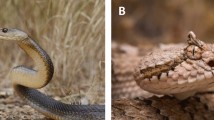Abstract
K+ channel blockers of scorpion venoms are of important value in studying pharmacology and physiology of specific K+ channel of cells. Based on the amino acid sequences of BmP01 previously characterized as a small-conductance Ca2+-activated K+ channel blocker, two “back to back” degenarate primers have been designed and synthesized for inverse PCR strategy, its full-length cDNA has been cloned from the venom gland of the Chinese scorpionButhus martensii. The cDNA is composed of 3 parts: 5′ UTR, ORF and 3′ UTR. The flanking sequence of translation initiation codon ATG is AAAATGA, which is highly conserved in scorpion Na+ channel toxin and protozoan genes, suggesting that these genes may have followed a common mechanism for translation initiation. The 3′ UTR contains poly(A) signal AATAAA. The open reading frame encodes a precursor of 57 residues with a signal peptide of 28 residues and a mature peptide of 29 residues. The signal peptide is rich in hydrophobic amino acid residues and its length is significantly different from that of the determined scorpion Na+ channel toxin. The deduced amino acid sequence of mature peptide is completely consistent with BmP01 previously determined by primary structure analysis.
Similar content being viewed by others
References
Garcia-Calvo, M., Leonard, R. J., Novick, J. et al., Purification, characterization and biosynthesis of Margatoxin, a component ofCentruroides margaritatus venom that selectively inhibits voltage-dependent potassium channels, Journal of Biological Chemistry, 1993, 268(25): 18866.
Aiyar, J., Rizz, J.R, Gutman, G. A. et al., The signature sequence of voltagegated potassium channels project into the external vestibule, The Journal of Biological Chemistry, 1996, 271(49): 31013.
Legros, C., Ceard, B., Bougis, P. E. et al., Evidence for a new class of scorpion toxins active against K+ channels, FEBS, 1998, 431: 375.
Zhu, X. S., Zhang, T. F., Zhu, Y. X., cDNA cloning and sequencing of two depressant insect toxins fromButhus martensii Karsch, Chinese Science Bulletin, 1996, 41: 1882.
Xiong, Y. M., Ling, M. H., Zao, D. et al., Two cDNA sequences encoding mammal neurotoxins fromButhus martensii Karsch, Acta Biochim.Biophys. Sinica, 1997, 29: 200.
Romi-Lebrum, R., Martin-Eauclaire, M.F., Escoubas, P. et al., Characterization of four toxins fromButhus martensii scorpion venom, which act on apamin-sensitive Ca2+ -activated K+ channels, Eur. J. Biochem., 1997, 245: 457.
Romi-Lebrun, R., Lebrun, B., Martin-Eauclaire, M. F. et al., Purification, characterization, and synthesis of three novel toxins from the Chinese scorpionButhus martensii, which act on K+ channels, Biochemistry, 1997, 36: 13473.
Tong, Q. C., Zhang, Y., Zhou, Z. N. et al., The characterizations and blocking effects on Ito of rat ventricular myocyte of new minipeptides fromButhus martensii Karsch, Acta Biochim.Biophys. Sinica, 1999, 31: 347.
Wu, G., Wei, D. S., He, F. H. et al., A K+ channel-blocking peptide from venom of Chinese scorpionButhus martensii Karsch, Acta Pharmacologica Sinica, 1998, 19: 317.
Fazal, A., Beg, O. U., Shafqat, J. et al., Characterization of two different peptides from the venom of the scorpionButhus sindicu, FEBS, 1989, 257: 260.
Buisine, E., Wieruszeski, J.M., Lippens, G. et al., Characterization of a new family of toxin-like peptides from the venom of the scorpionLeiurus quinquestriautus hebraeus, J.Peptide Res., 1997, 49: 545.
Zerrouk, H., Laraba-djebari, F., Fremont, V. et al., Characterization of P01, a new peptide ligand of the amamin-sensitive Ca2+ activated K+ channel., Int.J.Peptide Protein Res., 1996, 48: 514.
Feramisco, J. R., Smart, J. E., Burridge, K., Co-existence of vinculin and a vinculin-like protein of higher molecular weight in smooth muscle, Journal of Biological Chemistry, 1982, 257(18): 11024.
Feliciello, I., Chinali, G., A modified alkaline lysis method for the preparation of highly purified plasmid DNA fromEscherichia coli, Analytical Biochemistry, 1993, 212: 394.
Becerril, B., Vazquez, A., Garcia, C. et al., Cloning and characterization of cDNA that code for Na+-channel-blocking toxins of the scorpionCentruroides noxius Hoffmann, Gene, 1993, 128: 165.
Delabre, M. L., Pasero, P., Marilley, M. et al., Promoter structure and intronexon organization of a scorpion α-toxin gene, Biochemistry, 1995, 34: 6729.
Shen, Y. F., Expression and Control of Eukariotic Genes, Beijing: Higher Education Press, 1996.
Legros, C., Feyfant, E., Sampieri, F. et al., Influence of a NH2-terminal extension on the activity of KTX2, a K+ channel blocker purified fromAndroctonus australis scorpion venom, FEBS, 1997, 417: 123.
Author information
Authors and Affiliations
Corresponding author
About this article
Cite this article
Zhu, S., Zeng, X., Li, W. et al. Molecular characterization of a K+ channel blocker in the scorpionButhus martensii Karsch. Chin.Sci.Bull. 45, 739–743 (2000). https://doi.org/10.1007/BF02886181
Received:
Issue Date:
DOI: https://doi.org/10.1007/BF02886181




